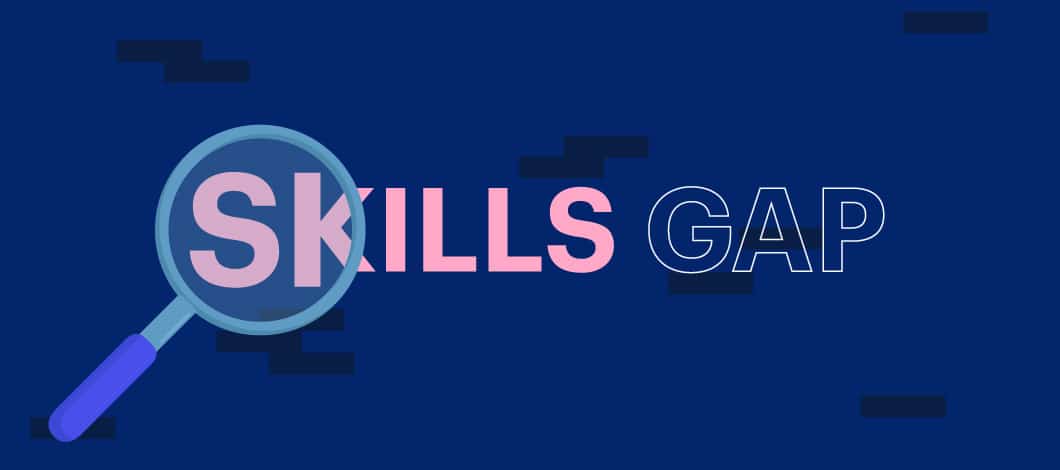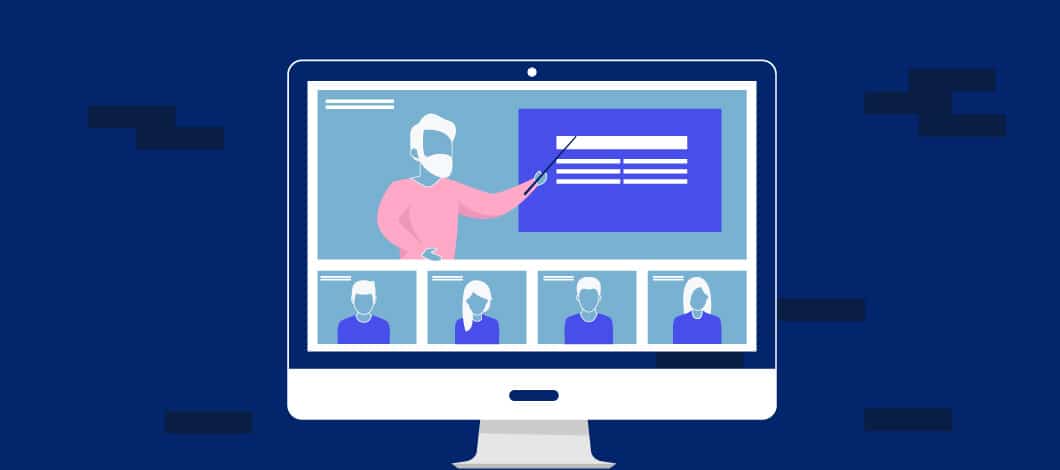Knowing how to upskill your employees has become critical for companies weathering the COVID-19 pandemic. Here’s our guide to upskilling workers. We’ll walk you through an 8-step plan for reskilling employees:
- Assign a skills training supervisor
- Assess your team’s skills gap
- Set skill-development goals
- Develop a training curriculum
- Schedule training time
- Monitor training progress
- Put new skills into practice
- Monitor performance and make adjustments
We’ll cover tools to help companies reskilling employees, too.
Benefits of Upskilling Employees
The coronavirus pandemic has forced many companies to lay off workers, reduce employee hours or shift operations to a remote workforce.
Even before COVID-19 struck, 87% of companies were experiencing skill gap challenges or expected them in a few years, according to a survey by management consulting firm McKinsey & Co. The coronavirus has aggravated this issue, forcing employers to make record job cuts in April, May and July, according to executive outplacement firm Challenger, May & Christmas. Meanwhile, 67% of employers were forced to make provisions for employees who normally worked in the office to work from home, according to law firm Seyfarth Shaw.
Upskilling can help alleviate the stress caused by these disruptions. If you’re forced to make do with a smaller staff, training workers to handle additional tasks can make operations more manageable. Workers with increased skill sets can take on some tasks previously handled by absent employees, allowing you to operate with a reduced staff. This can also reduce your need to outsource essential tasks, putting less strain on your budget.
If you’ve had to limit operations inside the workplace because of safety concerns, training workers how to handle tasks remotely can help you compensate. Remote workers trained to work over the internet can allow you to continue performing certain tasks, minimizing the amount of labor that needs to be performed by on-site workers.
How Upskilling Helps Your Business
Even if you’re not struggling with a smaller on-site staff because of the coronavirus, upskilling your workers can benefit you and your business. Lack of career-advancement opportunities can make workers disengaged, unproductive and inclined to seek work elsewhere.
A survey by research firm Gartner found that 40% of workers who leave employers cite perceived lack of future career development opportunities as a factor. Training your workers in new skill sets can help them see working at your company as conducive to their career development, increasing their engagement and productivity and making them less likely to quit.
Upgrading your employees’ skill sets can make them better workers, too. Training them to perform more types of tasks and complete them more efficiently can increase your productivity while lowering production time and costs. In all these ways, reskilling your workforce can benefit your company. (Also, consider team-building efforts.)

How to Empower Employees With an Effective Upskilling Strategy
You can reskill your workers more efficiently if you pursue a systematic strategy. A step-by-step upskilling procedure begins with assigning a skills training supervisor to assess your team’s needs and set strategic goals. You can then develop a targeted training curriculum and schedule training time for team members. Training can then be followed up by training assessment, application of new skills and performance monitoring.
Let’s take a more detailed look at how to put each of these 8 steps into practice:
1. Assign a Skills Training Supervisor
The place to begin your reskilling process is by assigning a supervisor to oversee the project. The supervisor will be responsible for duties such as conducting a skills assessment, selecting training curriculum and monitoring training progress.
The person selected for this position should have good project-management skills. They can be assisted by other team members with supporting skill sets.
2. Assess Your Team’s Skills Gap
The first task your training supervisor should undertake is assessing which skills your team lacks and needs to acquire. This type of analysis is formally known in business management as a needs analysis, training analysis or training needs analysis.
When performed by a large firm with sophisticated data analytics tools, it can involve a highly technical review. Here we will offer a simplified approach that does not require high technical proficiency and is suitable for smaller teams. If you have a larger organization and need a more technical analysis, training needs analysis templates (Google them) and other resources are available online, or you can hire a specialist or consulting firm with experience in this area.
When conducting a needs analysis, you can consider which skills have been lost because of COVID-19 layoffs and furloughs as well as skills that would generally improve your productivity, efficiency or cost-effectiveness.
You can brainstorm upskilling ideas by asking questions such as:
- What skills did team members who have been laid off or furloughed possess?
- Which essential skills is our team lacking because of layoffs or furloughs?
- What skills do our current team members possess?
- Which essential skills does our current team lack?
- Have any tasks been shifted to remote workers which require reskilling to perform at an optimal level?
- Which additional skills would allow us to function without additional hiring or outsourcing?
- Which additional skills would most increase our productivity?
- Which additional skills would most increase our efficiency?
- Which additional skills would most reduce our operational costs?
To answer these questions, you may find it helpful to take a skills inventory of your current staff as well as any staff members who have recently been laid off or furloughed.
3. Set Skill-Development Goals
Once you have identified some skills gaps in your organization, you can set skill development goals. You can establish goals for your organization as a whole, for individual departments and for individual team members.
For best results, your goals should specify:
- Which specific skills need to be acquired
- How these skills will impact operational performance
- How skill acquisition will be measured
- What timetable is expected for the skill to be acquired
To define how skills will impact operational performance, you can verbally describe expected results as well as use key performance indicators (KPIs) which measure results. You can establish KPIs for individual workers as well as for departments or your company as a whole.
An example of an individual performance KPI would be the average amount of time it takes an employee to complete a given task. The group equivalent of this KPI would be the average time it takes your team as a whole to complete the task. You can select whichever KPIs are relevant to your organization.
To measure skill acquisition, you can use a number of methods, including:
- Tracking tutorial completion rates using a Gantt chart (a bar chart which breaks progress toward a goal down into phases, allowing progress to be defined in percentages)
- Using skills assessment tests
- Tracking impact on performance using performance KPIs
Defining at the outset how you plan to track skill acquisition and its performance impact will help you assess later whether your training program is achieving its intended purpose.
4. Develop a Training Curriculum
After you’ve set skill development goals for your team members, you can begin developing a training curriculum for your workers. A curriculum plan should cover:
- Who will be supervising the training
- Which skills will be taught
- In what order those skills will be taught
- Which resources will be used to teach these skills
- Which software tools will be used for training
- How long training should take
Each worker should have their own customized curriculum designed for them. If multiple workers will be learning the same skill set, you can develop a group curriculum for that skillset and distribute it to individuals.
You don’t necessarily need to design a curriculum from scratch. In many cases, tutorials may be available through online resources and software apps. To save time, strive to locate existing curriculum materials whenever possible.
5. Schedule Training Time
After determining which curriculum each worker will be learning, you can schedule training time. In conjunction with other management personnel, your training supervisor can review worker schedules and workloads and determine when training could be conducted without disrupting operations. The supervisor also should set up procedures for notifying workers about training schedules and details.
6. Monitor Training Progress
Once workers begin training, your supervisor should monitor their progress. This will help ensure that training gets implemented in a timely manner. It also provides an opportunity for workers who are experiencing difficulty with training to get assistance.
Progress can be monitored using the Gantt chart method. Many software training tools have progress-monitoring features built in.
7. Put New Skills into Practice
A major goal of training is for workers to be able to apply new skills in real situations. To facilitate this, incorporate on-the-job learning into training programs whenever feasible. Follow up training with opportunities for workers to use their new skills.
For skills requiring a longer learning curve or involving a greater risk of making mistakes that could disrupt operations, live applications should be limited to small-scale projects until workers demonstrate skill mastery. Supervisors should be available to assist workers with questions about how to apply recently learned skills.
8. Monitor Performance and Make Adjustments
As employees begin applying new skills, it’s important to monitor how well they perform at using what they’ve learned. This helps ensure that training measures are effective. It also provides opportunities to take corrective measures such as providing feedback or scheduling additional training.
You can monitor performance by using KPIs, as described above. For best results, track KPIs both before and after training so that you can establish a baseline and evaluate the effectiveness of reskilling programs.
Tools for Upskilling Employees
Reskilling workers can be easier when you use supporting technology tools. A few categories of tools you may find useful for training workers include:
- Project-management platforms
- Learning-management systems (LMS)
- Learning-experience platforms (LXP or LEP)
- Videoconferencing apps
- Microlearning apps
Here’s what each of these types of tools can do for you, along with some leading examples from each category.
Project-Management Platforms
Upskilling supervisors can coordinate training through project management platforms. A project management tool allows supervisors to create tasks, assign them to workers, communicate with team members, set deadlines and track progress. Popular project-management tools include Jira, Microsoft Project and Smartsheet.
LMS Systems
Developed for online learning, LMS systems provide centralized digital interfaces to conduct online training. Trainers can use them to share course material with trainees, interact with participants, administer tests and track progress. Popular LMS tools include Adobe Captivate, Docebo and Google Classroom.
LXP and LEP Systems
Similar to LMS systems and compatible with them, LXPs provide platforms that employers can use to deliver digital content libraries. They allow employees to access online courses, videos, podcasts, articles and other content. Some content may come included, and trainers can add or select their own content. LXPs are distinguished by their use of artificial intelligence to provide recommendations for individual users based on their profile and history. Leading LXP tools include Bridge, 360Learning and Axonify.
Videoconferencing Apps
Video chat tools offer a useful way to deliver training that requires a visual demonstration. They can add a sense of personal presence when teaching, answering questions or providing feedback. Popular videoconferencing tools include Skype for Business, Microsoft Teams, Google Meet and Zoom.
Microlearning Apps
Microlearning apps are another useful tool for reskilling your workforce. Microlearning is an approach to training that distills information into small, bite-sized chunks which can be consumed over a mobile device in a short time.
Some microlearning apps allow you to present information that can be digested in gaming formats such as quizzes. Popular microlearning apps include TalentCards, MLevel and HandyTrain.
Upskill Your Workers to Upgrade Your Business
Upgrading your workers’ skill sets can help you maintain your productivity with a smaller staff during the COVID-19 crunch. It also can help increase employee efficiency and engagement even when you’re not struggling with downsizing issues.
No matter what situation your business is currently facing, following these steps to upskill your labor force can yield a rewarding return on investment which pays off in higher-skilled workers, increased employee retention and improved work output.












